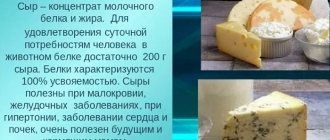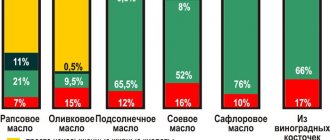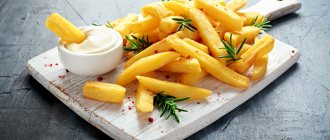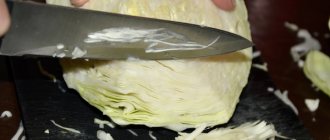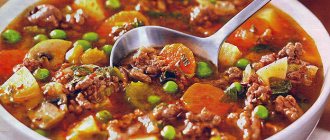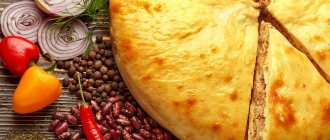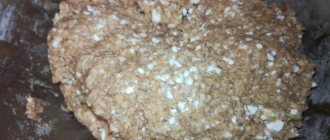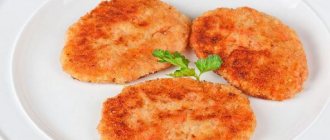Calorie counting is the prerogative of not only adherents of nutritional programs, diets and sports; nutritional control is often necessary to maintain health. Obesity, anorexia, and upcoming cardio operations require the patient to strictly adhere to the kcal norm, and absolutely all dishes need to be monitored, in particular the calorie content of borscht with chicken. Breast is considered the most dietary type of meat and is the basis of “light” nutrition systems, but the energy value of even chicken soup largely depends on the entire composition.
Chemical composition of borscht with chicken
The chemical composition of red and green borscht is slightly different. The table shows an analysis of the chemical composition of 2 types of soup: red with a standard set of ingredients (including fried onions and carrots) and green (with spinach and sorrel, without beets).
| Red borscht | Green borscht | |||
| Amount per 100 g, mg | % of daily value | Amount per 100 g, mg | % of daily value | |
| Vitamins | ||||
| A | 65 mcg | 7% | 105 mcg | 12% |
| B1 | 0.038 | 2.5% | 0.05 | 3.4% |
| B2 | 0.075 | 4.2% | 0.09 | 5% |
| B4 | 8 | 1.6% | 9.36 | 1.9% |
| B5 | 0.045 | 0.9% | 0.052 | 1% |
| B6 | 0.077 | 3.9% | 0.076 | 3.8% |
| B9 | 6 mcg | 1.5% | 8.8 mcg | 2.2% |
| C | 4 | 4.5% | 5.38 | 6% |
| E | 0.69 | 4.6% | 0.36 | 2.4% |
| H | 0.2 mcg | 0.4% | ||
| K | 6.4 mcg | 5.3% | 37 mcg | 31% |
| PP | 2.3 | 12% | 2.38 | 12% |
| Microelements | ||||
| Potassium | 191 | 7.7% | 227 | 9% |
| Calcium | 17 | 1.7% | 22 | 2.2% |
| Silicon | 9.8 | 33% | 6.5 | 22% |
| Magnesium | 11.36 | 2.8% | 18 | 4.5% |
| Sodium | 285 | 22% | 339 | 26% |
| Phosphorus | 45 | 5.6% | 49 | 6.2% |
| Chlorine | 237 | 10% | 364 | 16% |
| Iron | 0.6 | 3.4% | 1.3 | 7.5% |
| Iodine | 1 mcg | 0.7% | 1.5 mcg | 1% |
| Cobalt | 0.98 mcg | 10% | 1.1 mcg | 12% |
| Manganese | 0.07 | 3.6% | 0.09 | 4.6% |
| Copper | 69 mcg | 6.9% | 65 mcg | 6.5% |
| Molybdenum | 2.3 mcg | 3.4% | 2.1 mcg | 3% |
| Strong | 1.3 mcg | 2.5% | 1.4 mcg | 2.6% |
| Chromium | 1.9 mcg | 3.8% | 0.9 mcg | 1.8% |
| Zinc | 0.2 | 1.8% | 0.2 | 1.8% |
A plate of borscht with sour cream
When we say the word “borscht,” our imagination pictures a plate of a fragrant first course, bright red in color, with a white island of sour cream in the middle.
Sour cream and frying are essential components of real Ukrainian borscht
, which not only improve the taste of the finished dish, but also significantly increase its calorie content.
One tablespoon of homemade sour cream will add as much as 90 calories to borscht. If you use low-fat (10%) store-bought sour cream, then the calorie content of borscht when added will increase by only 35 kcal.
If you are a supporter of proper nutrition, do not fry onions and carrots in vegetable oil or fat, but throw them directly into the boiling broth. Replace high-fat homemade sour cream with a more dietary low-fat option.
Experiment, look for the most optimal option for you to prepare this wonderful dish. Through trial and error correction, you will definitely find the borscht recipe that will fully meet both your taste preferences and aesthetic requirements.
Perhaps almost everyone loves borscht - in any case, most of us will not refuse to try a delicious, aromatic soup with beets. The excellent taste of this dish is not the only thing worth loving about it - after all, borscht is also very healthy. This soup contains ingredients that are healthy for the body - beets, onions, carrots, garlic, cabbage, potatoes and meat. All these products are very useful. When preparing borscht, you can use either fresh or sauerkraut, but it is advisable to use meat that is not too fatty. As a snack for borscht, lard, bread with garlic or garlic dumplings, onions, herbs, croutons, etc. are used. Ukrainian borscht is always served with sour cream.
The calorie content of borscht is influenced by the calorie content of the meat that was used to prepare borscht - pork is the fattest and highest in calories, so the calorie content of borscht with pork will be high, but if you cook borscht with lean beef, then the calorie content of borscht will be much lower. Vegetarian borscht has the lowest calorie content - only 25-30 calories per 100 g, that is, less than 80 calories per cup. The calorie content of borscht with sauerkraut is higher than the calorie content of borscht, in the preparation of which fresh cabbage was used. The calorie content of Ukrainian borscht is about 90-100 kcal per 100 g, the calorie content of green borscht (on the bone, with sorrel, herbs) is 168 kcal per 100 g.
If you love borscht but are counting calories, you can reduce the calories in borscht in several ways. Prepare borscht using lean, boneless meat. This way you will reduce the calorie content of the borscht by reducing the calorie content of the broth in which the borscht is cooked. It is best to cook borscht in chicken or beef broth - it is lower in calories than pork or lamb. When preparing frying for borscht, it is traditional to fry onions and carrots in oil or lard. To reduce the calorie content of borscht, you can sauté them in a frying pan with water. The use of beans instead of potatoes also reduces the calorie content of borscht. There are few calories in borscht with beet tops instead of beets themselves (69 kcal per 100 g).
The calorie content of borscht will be lower if you season it not with mayonnaise, but with low-fat sour cream. It is better to serve bread with borscht not from premium wheat, but from rye or Borodino bread - it not only contains fewer calories, but also goes better with borscht.
The benefits and harms of the dish
The beneficial properties of borscht are as follows:
- a dish balanced in terms of the ratio of dietary fat, vitamins and minerals saturates the body with essential substances;
- cabbage and potatoes contain potassium salts, which help remove excess fluid and cholesterol;
- beets have vasodilating properties, improve cerebral circulation, and together with onions and cabbage help in the prevention of atherosclerosis;
- the consumption of boiled beets, according to research by scientists, is a preventive measure against the formation of benign and malignant tumors (coloring compounds have a detrimental effect on cancer cells, some of the vitamins and microelements in beets are included in the structure of enzymes that regulate hematopoietic processes);
- spices, onions, garlic, stimulating appetite, increase the secretion of gastric juice, and generally improve digestion and intestinal function;
- carrots activate the functioning of the stomach and intestines, have a positive effect on the functioning of the heart, and normalize blood pressure;
- sorrel, spinach, parsley (the main components of green borscht) have a beneficial effect on the functionality of the liver and stomach; serve as a prevention of vitamin deficiency and anemia, are characterized by a high content of vitamin C, which helps strengthen the immune system; reduce putrefactive processes occurring in the intestines;
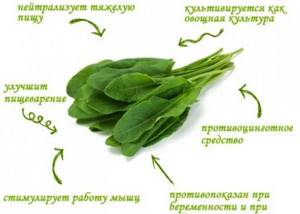
- Boiled vegetables contain a large amount of fiber, which has a laxative effect and serves as a soft sorbent, removing toxins and nitrates from the body.
Chicken, compared to other types of meat, is low in calories and high in vitamins and minerals.
100 g contains the following % of valuable substances from the daily value:
- potassium up to 6.5% – necessary for normal brain functioning, heart disease, hypertension;
- magnesium up to 4.8% - has a calming effect, dilates blood vessels, is necessary for atherosclerosis, liver and biliary tract diseases;
- phosphorus up to 20% - important for normal brain function and bone strength;
- iron about 8% (prevention of anemia);
- vitamin A – 4.4%: important for maintaining overall eye health, bone strength; has antioxidant properties; prevents the risks of developing cancer and cardiovascular diseases;
- B1 – 2.7% and B2 – 6.7% one of the main functions of which is the prevention of mental disorders and the fight against depression;
- RR – 63%: reduces cholesterol levels, normalizes the functioning of the nervous system and digestive organs;
- high protein content (28 g per 100 g of chicken breast), amino acids in particular, glutamine (helps build muscle mass).
High-quality chicken meat and broth are recommended for consumption in the following cases:
- those suffering from insomnia, stress, depression;
- for gout, polyarthritis, ulcers;
- for diabetes;
- serves as a prevention of strokes and atherosclerosis, normalizes blood pressure.
Possible harm from including borscht in the diet occurs in the following cases:
- vegetables (in particular, carrots, beets) grown in unfavorable conditions using large amounts of fertilizers are characterized by a high content of nitrates;
- chicken meat from an unscrupulous producer contains large quantities of antibiotics and hormones;

- Excess oxalic acid can cause kidney disease, osteoporosis, and caries.
To neutralize possible harm as much as possible, you should:
- skinning;
- soak the meat for 1-1.5 hours in water;
- drain the first broth;
- put a whole onion in the broth (onions can absorb some of the harmful substances), after preparing the broth, throw away the onion;
- Serve the dish with sour cream - sour cream neutralizes oxalic acid.
You should use soup with caution in the following cases:
- with gastritis;
- in case of disturbance of salt metabolism in the body;
- people with high stomach acidity.
Benefits of borscht
The dish contains many vitamins, elements, fiber, proteins, amino acids. It provides the necessary substances, its composition is balanced. Borscht is able to rid the body of waste and toxins and has a positive effect on the functioning of the stomach and intestines.
There are practically no contraindications; if you cook it according to all the rules, it will not cause any harm. The exception is if you are allergic to any component.
Detailed concentration of vitamins and minerals in percentage terms:
- vitamin A – 12.5%;
- vitamin E – 12%;
- vitamin K – 27.9%;
- chlorine – 26.5%;
- beta-carotene – 13%;
- cobalt – 11.5%.
Vitamin A is essential for healthy skin and eyes. It supports the functioning of the reproductive system and has a beneficial effect on the immune system.
Beta-carotene has antioxidant qualities. Vitamin E affects the functioning of the gonads and heart muscle. If there is a deficiency of the substance in the body, neurological abnormalities occur.
Calorie analysis of borscht with chicken
The calorie content of borscht with chicken depends on the ingredients of the recipe. The table shows a list of the most commonly used products with calorie content.
| Component | Number of calories per 100 g serving, kcal |
| Chicken breast | 113 |
| Chicken legs | 215 |
| Wings | 186 |
| Hearts | 185 |
| Necks | 170 |
| Stomachs | 154 |
| Paws | 215 |
| Potato | 77 |
| Carrot | 35 |
| Tomato | 24 |
| Onion | 41 |
| Beet | 42 |
| Tomato paste | 82 |
| White cabbage | 23 |
| Sauerkraut | 19 |
| Beans | 94 |
| Sorrel | 22 |
| Spinach | 23 |
| Champignon mushrooms) | 27 |
| Vegetable oil | 899 |
| Mayonnaise (67%) | 629 |
| Sour cream (15%) | 162 |
Dietary properties:
How many calories are in borscht with chicken, what dietary properties it has, all this is of great interest to those who lead a healthy lifestyle and monitor their health and figure. So we will try to answer these questions in the next article.
So here it is:
Borscht is such a wonderful dish that it can be delicious, even without meat, in a vegetarian version.

And if you put meat in the borscht, it will become even more appetizing, as well as filling and rich.
If you need to quickly prepare a delicious lunch, then you should choose borscht with chicken, its calorie content is low, and the chicken meat is tender and cooks very quickly. In addition, you will receive a tasty and aromatic broth that is suitable for both adults and children.
Only if you are cooking for children, then you should still replace the tomato paste with pureed tomatoes or natural tomato juice, preferably homemade.
A very healthy product is chicken broth. It is quite nutritious, and at the same time can quickly give strength. Because of this, it is the most popular product for patients during the recovery period.
However, don’t think that if you buy broiler chicken at your local supermarket, you can make broth from it that has healing properties. This decoction can be harmful. Stuffed with preservatives, drugs that stimulate its growth, and harmful substances that prolong the freshness of the product, the broiler is absolutely not suitable for broth.
Calorie content per 100 g
The table provides information on the calorie content of borscht in different preparations:
| Calorie content per 100 g, kcal | |
| Cabbage borscht with tomato dressing and mushrooms (with chicken legs) | 66 |
| With beets in a slow cooker (with breast fillet) | 73 |
| Option with beans and sauerkraut (with chicken wings) | 67 |
| Ukrainian red borscht with sour cream (1.2 parts chicken) | 95 + 49 kcal per 1 tbsp. l (30 g) sour cream 15% fat |
| Cabbage borscht with lean mayonnaise (with giblets) | 73 + 126 kcal per 1 tbsp. l. (30 g) lean mayonnaise |
| Dietary green chicken borscht with sorrel and spinach (with chicken breast) | 51 kcal (with egg) |
| Red-green borscht with cabbage and sorrel without frying | 62 + approximately 43 kcal for each ½ part of a hard-boiled chicken egg |
Daily intake of borscht
How much borscht can you eat every day? The exact amount depends on the person's needs and lifestyle. This dish contains most of the valuable vitamins and micronutrients. Therefore, if you wish, you can only eat borscht.

Photo source: shutterstock.com
But here you need to take into account that people employed in heavy production require 4000-5000 kcal per day. If you lead a sedentary lifestyle, then the number of required kilocalories drops to 2500.
Knowing the energy value of a particular type of dish, it will not be difficult to independently calculate the daily intake. For example, if the average calorie content of beef borscht is about 100 kcal per 100 grams, then you can eat a lot of it every day.
Borscht with chicken in a weight loss diet
Low-fat borscht may be included in the diet menu for weight loss. The soup will saturate the body with the necessary set of nutrients.
Basic recommendations for preparing dietary borscht are as follows:
- it is advisable to exclude potatoes, since they are a simple carbohydrate and are quickly absorbed by the body; without enough physical activity, potatoes turn into fat deposits;
- Avoid frying vegetables in oil;
- subject vegetables to minimal heat treatment;
- use skinless chicken breast (the lowest calorie part of the chicken) for cooking.
How many calories are in borscht with chicken?
Calorie counting is the prerogative of not only adherents of nutritional programs, diets and sports; nutritional control is often necessary to maintain health. Obesity, anorexia, and upcoming cardio operations require the patient to strictly adhere to the kcal norm, and absolutely all dishes need to be monitored, in particular the calorie content of borscht with chicken. Breast is considered the most dietary type of meat and is the basis of “light” nutrition systems, but the energy value of even chicken soup largely depends on the entire composition.
What determines the calorie content of homemade borscht?
Surely many people know the popular wisdom that “every cook makes different borscht” or “every housewife has her own borscht recipe.” And you can’t argue with that, because even if you prepare this traditional Slavic soup strictly according to your mother’s recipe, the taste will be completely different. It won't be worse or better, it will just be different.
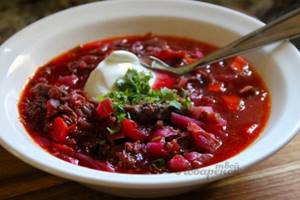
And the same situation arises with the energy value of the dish. It is not possible to say exactly and confidently how many calories are in borscht with chicken, because everyone has their own cooking recipe. Some people add beans to the soup, some like borscht with boiled beets, and others prepare the dressing in a frying pan.
Today we will carefully analyze all the most popular versions of borscht with chicken and find out how many kcal are contained in our lunch plate.
Calorie content of classic borscht

We took the classic recipe as the starting point for calculating the energy value of red cabbage soup:
- Chicken thigh for rich broth is the best choice. To prepare 3-4 liters of soup, you can take 400-600 g of legs, the calorie content of which will be 740-1100 kcal (100 g = 185 kcal). If you prepare soup from a “lighter” chicken breast, then the calorie content of the soup will be significantly reduced, because one hundred grams of white fillet contains only 113 kcal, which is 678 kcal in terms of 600 g.
- White cabbage - 27 kcal, which in terms of 500 g needed for soup is 135 kcal.
- Potatoes in classic borscht are an indispensable product. Three medium tubers will be enough, in total, plus another 228 kcal.
- Dressing for borscht is usually prepared from one carrot (75 g = 24 kcal), one onion (75 g = 35 kcal), 2 tbsp. tomato paste (46 kcal) and pre-boiled beets (150 g = 74 kcal) by frying and sautéing with the addition of vegetable oil (40 g = 360 kcal). Summing up all the components, we find that the dressing has a calorie content of 539 kcal.
- At the very end of cooking, a finely chopped bunch of greens, which weighs 40 grams (15 kcal) and chopped garlic (16 g = 23 kcal), are added to the borscht.
However, do not forget that when serving borscht, sour cream is also offered, the energy value of which, depending on the fat content, varies from 133 to 380 kcal, or mayonnaise, the calorie content of which is on average 660 kcal or 220 kcal if you decide to use “light” Calve."
Step-by-step recipes for borscht with chicken for regular and diet menus
The nutritional value of the finished dish depends on the quality of the ingredients used.
It is recommended to prepare the broth as follows:
- The chicken must be washed well, peeled and soaked in water for 1 hour.
- Afterwards, the meat is washed with running water, placed in boiling water and cooked for 3-5 minutes.
- The first broth is poured out. The second time, fill the pan with water and after boiling, add the chicken. If scale forms, it must be collected.
- Then add salt, pepper and 1 onion (unpeeled, but always thoroughly washed with the root trimmed) to the pan and cook for 1-1.5 hours.

- Remove the onion from the finished broth and discard.
Cabbage borscht with tomato dressing and mushrooms
Fresh or dried mushrooms are suitable for this recipe. In the first case, the aroma will be more intense.
You need to prepare:
- 500 g chicken legs;
- 2-2.5 liters of water;
- 250 g fresh mushrooms or 50 g dried;
- 1 large beet;
- ½ carrot;
- 2 onions;
- 2 potatoes;
- 2 tbsp. l. tomato paste or tomatoes in their own juice;
- 200 g fresh cabbage;
- 2 cloves of garlic;
- 1 bay leaf;
- 1-2 tbsp. l. vegetable oil;
- fresh or dried herbs (dill, parsley, green onions);
- salt, pepper, spices (for example, cumin) to taste.
If dried mushrooms are used, they should be washed, brewed with boiling water and left to swell for 30-40 minutes.
Cooking steps:
- Well-washed and skinned chicken legs are placed in boiling salted water seasoned with pepper with a whole onion and boiled until tender, about 1 hour.
- The boiled meat is removed from the pan and separated from the bone.
- While the chicken broth is cooking, you can prepare the dressing. To do this, you need to chop onions and carrots into cubes, grate or cut beets into strips, and chop cabbage. If fresh mushrooms (champignons) are used, they need to be peeled and chopped into slices or cubes for frying.
- First, fry the champignons in a frying pan in vegetable oil with a little salt until cooked (15 minutes).
- Then remove the mushrooms and fry the onions and carrots in the same oil over medium heat for 3-4 minutes, add the beets with tomato paste and fry the vegetables for another 5 minutes.
- If dried mushrooms are used for borscht, then they should be dipped first into the finished boiling broth, after first rinsing them again to remove sand and cutting them into cubes. At this stage, add bay leaf.
- After 10 minutes, chopped potatoes are dipped into the broth, brought to half-cookedness and cabbage, fried meat, and meat are added.
- Check the broth for taste, add salt and pepper if necessary, add fried mushrooms.
- 1-2 minutes before the borscht is ready, add garlic passed through a press, chopped fresh or dried herbs, bring the soup to a boil and turn it off.

Let the soup sit for at least 1 hour.
While frying mushrooms, you can add 1-2 tbsp for a more intense taste and aroma. l. balsamic vinegar.
With beets in a slow cooker
A multicooker simplifies the cooking process. The process is almost completely automated, with the exception of the roasting stage. It will not be possible to drain the first broth, so the meat should be rinsed well. It is recommended to use chicken fillet for borscht in a slow cooker.
You will need the following amount of products:
- 300-400 g chicken fillet;
- 1 carrot;
- 1 onion;
- 1 large beet;
- ripe tomato;
- 200 g cabbage;
- 2-3 potatoes;
- 1/2 sweet pepper;
- 1-2 tbsp. l. vegetable oil;
- 1 tbsp. l. lemon juice;
- 1-2 cloves of garlic;
- salt, pepper to taste;
- greenery.
The broth preparation time may vary depending on the power of the appliance.
Cooking steps:
- Onions and carrots must be washed, peeled and chopped into strips.
- The beets are grated. The tomato is peeled, first dipped in a ladle with hot water, and finely chopped.
- Next, pour vegetable oil into the multicooker bowl, turn on the “frying” mode, lay out the onions first, and after 3 minutes the carrots. Vegetables are salted and fried for another 5-7 minutes.
- Then put 1/3 of the beets and tomatoes into the slow cooker and fry everything together for an additional 5-7 minutes.
- Cut the fillet into cubes, place in a bowl with the vegetables and lightly fry for 10 minutes.
- Then I pour 1.5-2 liters of water into the multicooker, turn on the soup mode (up to 2 hours) and leave the broth to cook under a closed lid.
- At this time, the remaining beets need to be poured with boiling water and left to infuse.
- 30-40 minutes before the soup is ready, I add peeled and cut into strips potatoes, 20 minutes - cabbage.
- 10 minutes before turning off, pour beetroot juice into the soup, add more grated beets if desired, taste the broth, add salt and pepper.
- After 2 minutes of readiness, add garlic and lemon juice, passed through a press.
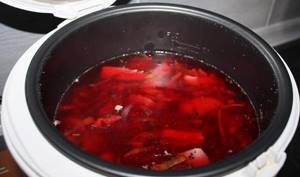
When serving, the dish is decorated with chopped herbs.
You can simplify the cooking process by adding all the ingredients to the prepared broth at once.
Option with beans and sauerkraut
Sauerkraut is notable for its high content of vitamin C. Beans are a source of vegetable protein. Beans can completely replace potatoes.
For chicken borscht with beans and sauerkraut, calorie content 67 kcal/100 g, the following set of products is required:
- 400 g wings;
- 1 beet;
- 1 onion for broth;
- ½ onion for frying;
- ½ carrot;
- 250 g sauerkraut;
- 100 g of tomatoes in their own juice;
- 2 cloves of garlic;
- 200 g canned beans or 150 g raw;
- 1-2 pcs. potatoes;
- 2-2.5 liters of water;
- salt, sugar, pepper to taste;
- 2 g cumin;
- Bay leaf;
- 1-2 tbsp. l. vegetable oil.
Before preparing the broth, the wings are washed. Each wing is cut into 2 parts - the elbow and the shoulder; the tips can be cut off. The finished wings are left whole or the meat is separated from the bone. The broth preparation time is 40 minutes.
Beans can be eaten raw or canned. The raw one should be soaked overnight in water and begin to cook along with the broth.
Cooking steps:
- While preparing the broth, boil the beets in a separate pan in water without salt until soft. The root crop is pre-washed and the top and root are cut off.
- For the dressing, chop the onion and carrots into strips or cubes and fry in a frying pan until golden brown. Then add tomatoes and sauerkraut to the vegetables and simmer everything together for 3-5 minutes.
- Add bay leaf and peeled, diced potatoes to the finished broth.
- After 10 minutes, add roasted beans (if using canned ones), boiled beets, grated.
- The dish is tasted, additionally salted and peppered, spices, sugar, and meat are added.
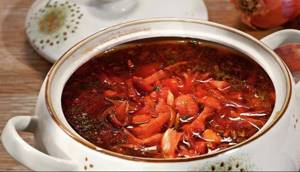
- Borscht is cooked until the potatoes are ready. 2 minutes before turning off, add garlic passed through a garlic press into the soup.
Ukrainian red borscht with sour cream
According to historical data, borscht first appeared on the territory of Kievan Rus. Borscht was prepared using meat broth on holidays and on Sundays; on other days, the meat was replaced by frying lard, onions, and garlic. For spiciness, red hot pepper was added so that the borscht was red - beets and beet kvass.
For Ukrainian borsch you will need:
- ½ chicken;
- 5 l. water;
- 2 beets;
- 300 g cabbage;
- 1 large carrot;
- 2 onions;
- ½ lemon;
- 2 tbsp. l. vegetable oil;
- 25 g lard for frying beets (optional);
- 50 g salted lard;
- 3 ripe tomatoes;
- salt, peppercorns, herbs (parsley, dill) - to taste;
- 2 cloves of garlic;
- sugar.
Borscht with chicken, whose calorie content is significantly lower than a similar dish with pork or beef, is prepared as follows:
- In a separate pan, cook chicken broth with salt and pepper. Afterwards, the chicken is removed, cooled, and the meat is separated from the bones.
- Chop carrots and onions into small cubes and fry in vegetable oil for 5 minutes. Then peeled tomatoes are added to the vegetables and simmered for another 5 minutes.
- The beets are chopped into thin strips and fried in vegetable oil or melted lard for 10 minutes, generously sprinkled with the juice of ½ lemon.
- Next, you need to prepare a dressing from salted lard and garlic. To do this, finely chopped lard and garlic are ground in a mortar.
- Add peeled diced potatoes, a mixture of peppercorns and bay leaves to the finished boiling broth; after 10 minutes, add shredded cabbage and meat.
- 5 minutes before readiness, add the remaining fried vegetables to the soup, salt, pepper and add sugar.

- After turning off, season the soup with lard and garlic seasoning and leave to steep for 5-6 hours.
Cabbage borscht with lean mayonnaise
Borscht cooked with offal and chicken products will be no less tasty:
- paws;
- neck;
- liver;
- heart;
- stomachs;
- head;
- wings.
These by-products are low-calorie parts of poultry. Chicken feet are considered one of the healthiest, a source of collagen.
A set of chicken giblets for soup is selected based on taste preferences. Depending on this, the cooking time for the broth will vary. Necks, hearts, legs are boiled for an average of 1 hour, stomachs up to 1.5 hours.
For cabbage borscht you will need:
- 500 g chicken giblets;
- 300 g cabbage;
- 1 beet;
- 1 carrot;
- 1 onion;
- 2-3 pcs. potatoes;
- 1 tbsp. l. apple cider vinegar;
- salt, sugar, spices (you can use suneli hops) - to taste;
- 1 clove of garlic;
- Bay leaf;
- greens (parsley, green onions);
- 2 tbsp. l. vegetable oil.
You can serve the dish with homemade lean mayonnaise, the calorie content of which is much lower than store-bought mayonnaise (approximately 423 kcal per 100 g, store-bought - on average 629 kcal).
For mayonnaise you will need:
- 100 ml water;
- 100 ml vegetable oil;

Even if the mayonnaise is light, the calorie content of borscht with chicken and mayonnaise will be higher than without it - 1 tbsp. l. corn starch (without a slide);
- 1-2 g salt;
- ½ tsp. mustard;
- ½ tsp. Sahara;
- 1 tsp. lemon juice.
Before preparing the broth, the giblets are carefully processed:
- remove the yellow film from the chicken feet, remove the claws, cut off the phalanges of the fingers;
- Fat, blood clots, and large vessels are removed from the hearts;
- the stomachs are incised, the contents are cleaned, the yellow film and soft cartilage are removed.
The giblets are removed from the finished broth.
Cooking steps:
- To prepare the dressing, fry onions, carrots, and chopped garlic cut into strips in vegetable oil and salt in a saucepan. After 5 minutes, add grated beets to the vegetables, add 1 tbsp. l. apple cider vinegar and simmer all together for about 5 minutes.
- Add diced potatoes, bay leaves, and pepper to the prepared broth.
- After 10 minutes, add shredded cabbage to the soup, and after another 10 minutes, fry it. At this stage, boiled giblets are added to the soup or added in portions when serving.
- The soup is salted, sugar and spices are added. When the potatoes are ready, turn off the dish and leave to steep for at least 1 hour.
The finished borscht is poured into plates, herbs and mayonnaise are added.
To prepare mayonnaise you need:
- In a small saucepan you need to boil 60 g of water.
- Starch is added to the remaining water and mixed until it is completely dissolved.
- Afterwards, dissolved starch is gradually introduced into the boiling water with constant stirring. The resulting mass is simmered over low heat until thickened.
- Cool the finished mixture to room temperature, add the remaining ingredients and beat with a blender until smooth.
Dietary green chicken borscht with sorrel and spinach
For dietary chicken borscht, it is recommended to use chicken breast.
The full list of products includes:
- 1 chicken breast;
- 1 bunch each of sorrel and spinach;
- 1 PC. potatoes;
- 1 onion;
- ½ carrot;
- 1 chicken egg;
- salt, pepper to taste;
- parsley, green onions for serving.
Borscht with chicken, the calorie content of which is 51 kcal/100 g, includes the following preparation steps:
- Remove the chicken breast from the finished chicken broth and cut the meat into portions.
- Shredded potatoes are placed in the boiling broth.
- When the potatoes are cooked until half cooked, carrots, spinach, and sorrel cut into strips are added to the soup. The soup is salted and peppered to taste and simmered over low heat until the potatoes are ready.
- 2 minutes before turning off, break a raw egg into the borscht and mix the ingredients thoroughly.
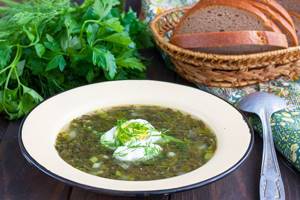
- When serving, each serving is sprinkled with fresh herbs.
Red-green borscht with cabbage and sorrel without frying
The absence of the stage of frying vegetables significantly reduces the calorie content of the dish.
For preparation you will need:
- 400 g chicken meat on the bone;
- 200 g cabbage (or Peking cabbage);
- 1 bunch each of spinach and sorrel;
- 1 carrot;
- 2-3 potatoes;
- 1 onion (for making broth);
- 1 beet (preferably with tops);
- chicken eggs (at the rate of ½ part per serving of soup);
- greenery;
- salt, spices to taste;
- lemon slice;
- 1-2 tbsp. l. tomato paste.
Chicken broth is boiled according to the standard preparation procedure, adding a whole onion.
Cooking steps:
- While the broth is boiling, you need to prepare the vegetables: carrots, potatoes, cut into cubes; spinach, sorrel, and beet tops are chopped into strips.
- The beets are cleaned, cut into circles up to 5 mm thick and baked in an oven preheated to 180⁰ for 25 minutes. It is recommended to drizzle the beetroot slices with olive oil and lightly sprinkle with salt.
- In a separate ladle you need to boil hard-boiled eggs.
- First add potatoes to the prepared broth and cook until half cooked. Then add grated baked beets, cabbage, and carrots. At this stage, add tomato paste, salt and pepper to taste.
- After 3 minutes, add spinach, sorrel, beet tops and cook the soup until the potatoes are ready.
- Place a slice of lemon into the finished borscht, which is removed after 3 hours.
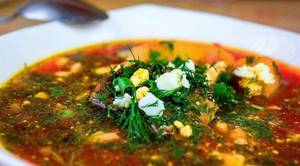
The dish is served with half a boiled egg, sprinkled with herbs and sour cream.
Chicken borscht, unique in its properties, consists of an accessible list of ingredients. Including a low-calorie version of soup on the menu while losing weight will help reduce the stress on the body associated with weight loss and restricting food consumption.
Borscht is delicious, aromatic, filling!
Borscht is considered a dish of Ukrainian cuisine. But we have long considered it traditional. You can cook this treat in different ways. Let's look at the most interesting and original option.
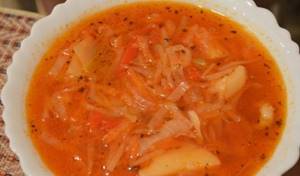
Ingredients:
- chicken thigh;
- carrot - one piece;
- large beets - one root vegetable;
- onion - one head;
- white cabbage – 0.3-0.4 kg;
- tomatoes - two pieces;
- sweet pepper - one fruit;
- dried basil - one teaspoon;
- refined vegetable oil;
- laurel leaves - two - three pieces;
- tomato paste - two tables. spoons;
- salt.
Preparation:
- Pour purified water into the pan. There is no need to fill it to the brim.
- Place the pan on the stove. Let's salt the water.
- Wash chicken thigh (medium size).
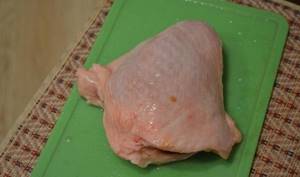
- Let's put it in a saucepan.
- Cook the chicken for thirty to forty minutes. Don't forget to remove any foam that appears. When the broth comes to a boil, turn the burner level to minimum.
- In the meantime, we prepare the remaining components. Peel and wash the potatoes. Cut root vegetables of the same size into medium pieces.
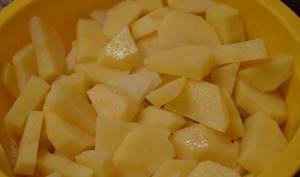
- Clean the onion and finely chop it.

- Let's clean the beets. Grate it on a coarse grater.
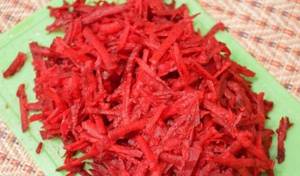
- Peel and wash the carrots.
- Let's grate it on a large-caliber grater. By the way, if you have a frozen vegetable, use it.
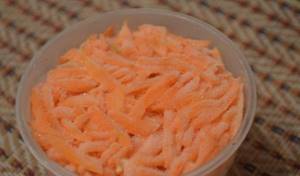
- Let's wash the pepper. It is better to choose a red fruit, then the borscht will be bright and beautiful.

- Remove seeds and stalks from the pepper. Cut it into small pieces.
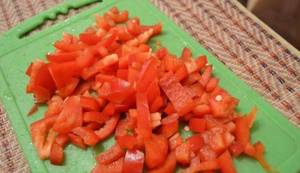
- In a frying pan with high sides, heat the refined vegetable oil.
- Place assorted vegetables in it - pieces of onion, pepper, carrot and beetroot shavings.
- Fry for six to seven minutes, stirring.
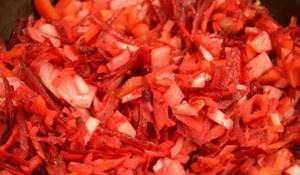
- Let's wash the tomatoes. Let's cut them finely.
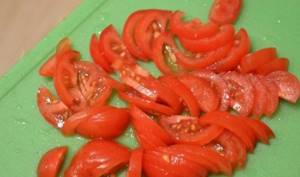
- Add the tomatoes to the pan with the vegetables. While stirring, simmer everything together for two to three minutes.
- In the meantime, let's prepare the sauce. Dilute the tomato paste with a glass of purified water (it should not be hot).
- Stir the sauce until smooth.
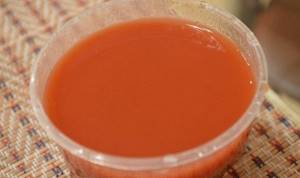
- Add the resulting sauce to the frying pan. Stir and simmer for five to seven minutes.
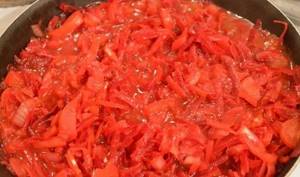
- Shred the cabbage thinly.
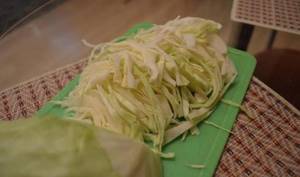
- By this time the chicken was cooked. Remove the meat from the pan and place it on a plate.
- Add cabbage and potatoes to the broth.
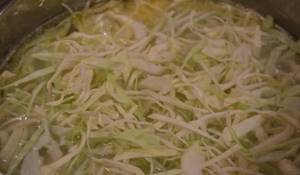
- Cook the borscht until the potatoes are ready.
- Add the frying, stir and set the burner to the minimum level.
- Add basil and laurel leaves.
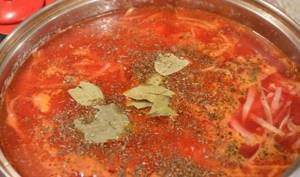
- Boil the borscht for another five minutes. Then let it sit for ten minutes under a closed lid.
On a note! The meat can be served separately with the borscht, or slice it and return it to the pan five minutes before the end of the cooking process. It is better to serve borscht with chopped herbs and sour cream.
Red borscht with fresh cabbage and beets in chicken broth
- Ingredients
- Step by step recipe
- Calorie content
Each family has its own special borscht recipe, which is passed down from generation to generation. I learned to cook borscht already as a student, when I had to go to study in St. Petersburg with my future husband, where we moved into a separate apartment and provided for our own life. The first experiments were not very successful, but they learn from mistakes. For many years I have been developing the very recipe that we like, and I want to share it with you.
Ingredients for making red borscht with cabbage
A set of products for 6 servings.
- Chicken thighs 2 pcs.
- Cabbage ¼ large head
- Carrot 1 pc.
- Onion 1 pc.
- Potatoes 4 pcs.
- Beetroot 1 pc.
- Tomato paste 2 tbsp. l
- Table vinegar 1 tbsp. spoon
- Garlic 1 clove
- Salt, pepper, bay leaf to taste
- Dill and parsley to taste
Red borscht with cabbage and beets in chicken broth - step-by-step recipe with photos
A step-by-step method for preparing delicious and healthy red borscht with cabbage.
Fill the meat with water and cook for an hour with the lid open. Turn off, cover with a lid and leave for half an hour. Then take the meat out onto a plate and let it cool. Then we take it apart into pieces. Cut the potatoes and put them in the broth, cook for 15 minutes, then add salt.
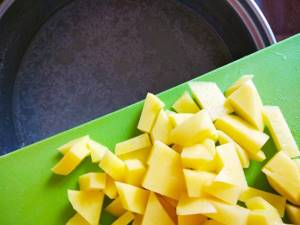
Mash the boiled potatoes partially with a potato masher.
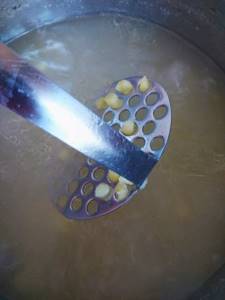
Chop the cabbage and add it to the broth with the already prepared potatoes, cook for 10 minutes.
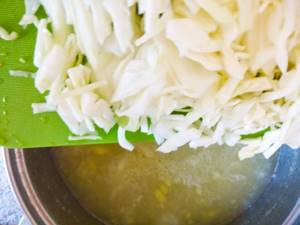
While the potatoes are cooking, fry them. Sauté onions and carrots.
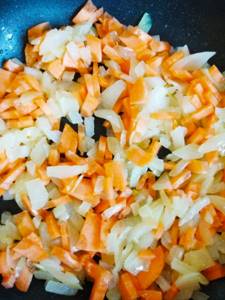
Add the beets to the same pan and pour vinegar over them evenly. Fry everything together until the vinegar evaporates.
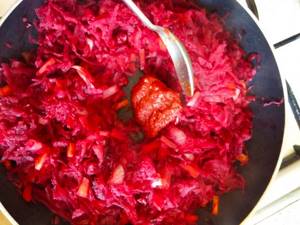
Add tomato paste and stir the fry well so that the tomato paste is distributed evenly and fried. Sometimes I also add 2 tablespoons of tomatoes in their own juice and fry them the same way. Add the roast to the broth and bring to a boil, cover with a lid and cook for 20-30 minutes. Then add bay leaf, pepper, garlic, herbs. Cook for 10 minutes. Turn off and leave the borscht without a lid for half an hour.
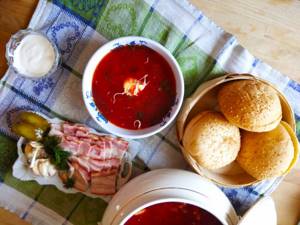
Calorie content of red borscht with cabbage
Energy value of red borscht with cabbage per 100 g serving.
- Calorie content 46.3 kcal
Red borscht with cabbage and beets in BZHU chicken broth
- Proteins 4.1 g.
- Fats 1.6 gr.
- Carbohydrates 3.9 g.
You have learned how to properly cook red borscht with cabbage and beets in chicken broth, delicious, tell the secret recipe to your friends on social networks!
What is the calorie content of borscht per 100 grams: BJU for borscht with beef, chicken, pork, without meat
Borscht is one of the most popular first courses in Slavic cuisine. In Rus', borscht has been known for many centuries; sayings and proverbs are dedicated to it. And there is nothing surprising about this. After all, the traditional recipe for red soup includes only natural ingredients that are beneficial to the human body. This is a perfectly balanced and satisfying first course that can cover your daily energy requirement. But does it allow you to lose weight? What is the calorie content of borscht prepared according to different recipes?

- Calorie content of borscht with beef
- Calorie content of borscht with pork
- Calorie content of borscht with chicken
- Calorie content of borscht without meat
- Calorie content of borscht with sour cream
- Composition and nutritional value of borscht
- Daily intake of borscht
- The benefits and harms of borscht
- Borscht calorie table
- Video
Calorie content of borscht with beef
Most often, a hearty and nutritious soup for the whole family is prepared with beef (on the bone or with fillet). What is the energy value of classic borscht? Calculating the calorie content of the first course per 100 grams, we get 50.1 kcal. The BJU of such a soup, which is prepared by cooking without draining, is:
- proteins - 3.9 g;
- fats - 2.5 g;
- carbohydrates - 3.1 g.
Considering that the traditional portion served in a deep plate is 250 grams, 1 plate contains 125.3 kcal. At the same time, BZHU is presented in 9.8/6.3/7.8 g, respectively.
If you use fresh cabbage instead of sauerkraut to prepare borscht, the energy value and other indicators will be higher.
Calorie content of borscht with pork
What is the calorie content of red borscht, which is prepared with pork? If we take into account that the classic recipe involves the creation of fried vegetables, then 100 grams of the first course contains 68 kcal. The same amount of food accounts for 5.5 g of protein, 3.6 g of fat and 3.5 g of carbohydrates.

